Away from the city, river traffic diminished but never ceased. In this part of Peru the waterways are the thoroughfares. I found it quite remarkable to be in a land devoid of roads after a lifetime of simply assuming their existence. In Amazonian Peru, if there is no trail to walk, getting from Point A to Point B involves paddling or cruising. With the lessened boat activity, my attention now turned to my natural surroundings. Peeking out from under 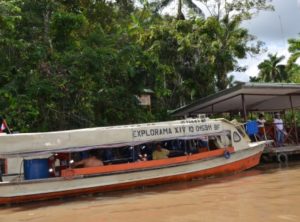 the rapido’s roof, I admired a sapphire sky so dazzling that it seemed a new name for this shade of blue needed invention. Suspended in this azure sky were giant pillows of marvelously snowy cumulus clouds. I felt that surely I was the first person ever privileged to see a sky so beautiful. The latte-colored waters of the river rolled onward beneath us. Upon its surface floated logs (our boatman had to be diligent), water lettuce, hyacinth, the occasional whole tree, and even small islands of soil with their attendant vegetation which had been ripped from the shoreline. What creatures sailed aboard these craft I wondered? To what destination were they bound? The great naturalist Charles Darwin long ago speculated that such rafts, carried out to sea from a river mouth, were the means by which many pioneering organisms reached their far ports – the Galapagos Islands for example.
the rapido’s roof, I admired a sapphire sky so dazzling that it seemed a new name for this shade of blue needed invention. Suspended in this azure sky were giant pillows of marvelously snowy cumulus clouds. I felt that surely I was the first person ever privileged to see a sky so beautiful. The latte-colored waters of the river rolled onward beneath us. Upon its surface floated logs (our boatman had to be diligent), water lettuce, hyacinth, the occasional whole tree, and even small islands of soil with their attendant vegetation which had been ripped from the shoreline. What creatures sailed aboard these craft I wondered? To what destination were they bound? The great naturalist Charles Darwin long ago speculated that such rafts, carried out to sea from a river mouth, were the means by which many pioneering organisms reached their far ports – the Galapagos Islands for example.
Along the shore, the vegetation became more dense as we moved away from civilization. Because of the greater available sunlight along streams, plant growth tends to be thicker here than within the forest itself. Some speculate that early tropical explorers, using streams as corridors for their explorations, coined the term “jungle” (from the Sanskrit word jangala) for the thick, tangled, impenetrable vegetation they saw. Thus the word jungle came into common usage for the rainforest itself. This is misleading because, within the forest itself, less than ten percent of available sunlight reaches the ground. Although there is much vegetation in the forest understory and ground layers, it is not dense and impassable.
As we motored on, trees typical of the flood-prone shores of the river passed in review – Cecropia (keep an eye out for three-toed sloths Pablo counseled); Ceiba, Mimosa, and Ficus were common. Each of these had its own story to tell in the complex web of ecological relationships that flourished here. Such trees must be highly tolerant of having their feet wet. Melting of the snow in the Andes far to the west releases a seasonal flood of water. In November the river begins to rise, sometimes reaching thirty or forty feet above the level at which I now rode in June ( “winter” in the southern hemisphere). During the South American summer (our winter), piranhas, pacus, electric eels, and pink river dolphins would swim among the boles of the trees I now saw standing high and dry. The occasional Mauritius palm towered along the shore as well, a representative of the Neotropic’s hugely diverse palm 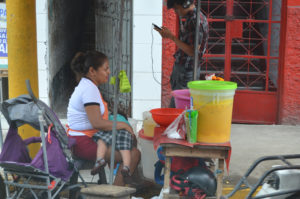 tribe. In these parts, this palm is generally referred to as aguaje and is prized for its fruits which find their way into delights ranging from ice cream to juice.
tribe. In these parts, this palm is generally referred to as aguaje and is prized for its fruits which find their way into delights ranging from ice cream to juice.
Within two hours our rapido slowed and moved ac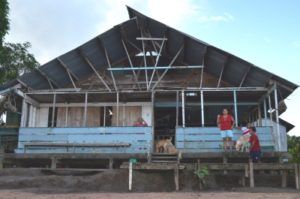 ross the river into a small stream (a quebrada) called the Yanamono. Slowly we idled past the home, small store, and bar of the Guerra family which stood at the tributary’s mouth. Close by stood the rum factory, the source of the aguardiente served in their little bar. Later I was to learn much about the potency of this sugar cane derivative. Gliding ahead we passed, on the left bank, the co
ross the river into a small stream (a quebrada) called the Yanamono. Slowly we idled past the home, small store, and bar of the Guerra family which stood at the tributary’s mouth. Close by stood the rum factory, the source of the aguardiente served in their little bar. Later I was to learn much about the potency of this sugar cane derivative. Gliding ahead we passed, on the left bank, the co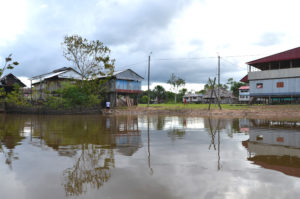 llection of houses representing the little village of Palmeras. Here lived a community of indigenous Yagua people.
llection of houses representing the little village of Palmeras. Here lived a community of indigenous Yagua people.
Finally, just past the village, the dock and buildings of the Explorama Lodge came into view. Here was my base camp for the next two weeks. I felt as though I should pinch myself; at long last I had made it to the Amazonian rainforest. 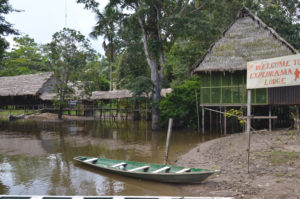
Explorama Lodge was begun in 1964 by the late Peter Jensen, an American who originally came to Peru as a Peace Corps volunteer. After traveling to Iquitos, Mr. Jensen developed an abiding love of the Amazonian rainforest and the Peruvian people and spent the remainder of his life with them. Peter was a visionary and pioneer in the field of ecotourism. His dream of helping others experience and learn about 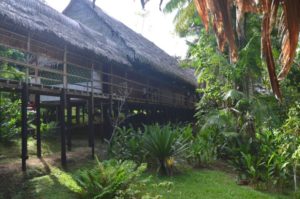 the tropical rainforest led him to build not only Explorama Lodge but other facilities as well. These include Ceiba Tops which sits on the Amazon twenty-five miles below Iquitos. With air conditioning, hot water, and a pool, it is an eco-destination for those who prefer less rustic rainforest accommodations. There is another Explorama facility on the Sucusari River (a tributary of the Napo) roughly one hundred miles east of Iquitos which is called ExplorNapo Lodge. A short hike from here brings one to the ACTS (Amazon Conservatory of Tropical Studies) Field Station, a place many visitors consider the highlight of their trip to the Explorama properties. Originally known as ACEER (Amazon Center for Environmental Education and Research), the ACTS field station is as the name suggests a focal point for tropical research. But here Explorama also maintains lodging for their guests similar to that at their other properties. However, the big attraction at ACTS is the famous canopy walkway. Suspended within the
the tropical rainforest led him to build not only Explorama Lodge but other facilities as well. These include Ceiba Tops which sits on the Amazon twenty-five miles below Iquitos. With air conditioning, hot water, and a pool, it is an eco-destination for those who prefer less rustic rainforest accommodations. There is another Explorama facility on the Sucusari River (a tributary of the Napo) roughly one hundred miles east of Iquitos which is called ExplorNapo Lodge. A short hike from here brings one to the ACTS (Amazon Conservatory of Tropical Studies) Field Station, a place many visitors consider the highlight of their trip to the Explorama properties. Originally known as ACEER (Amazon Center for Environmental Education and Research), the ACTS field station is as the name suggests a focal point for tropical research. But here Explorama also maintains lodging for their guests similar to that at their other properties. However, the big attraction at ACTS is the famous canopy walkway. Suspended within the 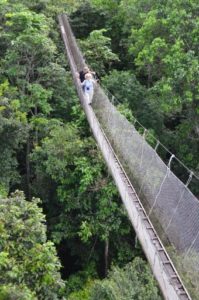 rainforest canopy, this system of walk-boards, cables, and netting extends for a third of a mile through this lofty realm. Upon this high – and tangibly thrilling – causeway guests and researchers are able to access a stratum of the rainforest which is otherwise inaccessible to those without special climbing equipment and skills. As you may discern, Peter Jensen’s legacy is a tropical rainforest ecotourism destination of extraordinary vision and accomplishment.
rainforest canopy, this system of walk-boards, cables, and netting extends for a third of a mile through this lofty realm. Upon this high – and tangibly thrilling – causeway guests and researchers are able to access a stratum of the rainforest which is otherwise inaccessible to those without special climbing equipment and skills. As you may discern, Peter Jensen’s legacy is a tropical rainforest ecotourism destination of extraordinary vision and accomplishment.
I was soon shown to my room at Explorama Lodge and found it delightful. The accommodations were somewhat Spartan but quite comfortable. The small chamber, one of seventy-two, contained two mosquito-netted beds; a 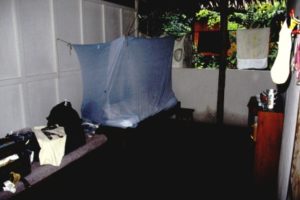 nightstand held a pitcher of river water and metal wash pan, a kerosene lamp on the wall provided light. Such lamps also lined the walkways interconnecting the many lodge buildings. Their soft, soothing light lent a magical nighttime aura to the lodge grounds. The walls of the room extended to a height of eight feet on three sides. The back wall was about four feet in height and opened directly into the surrounding forest. It was unscreened but had curtains which could be drawn closed. Towering far overhead was the actual roof of the guest building. The underside – my ceiling – revealed an artistic pattern of interwoven irapay palm leaves. The leaves had been assembled into units of roofing known as crisnejas. These
nightstand held a pitcher of river water and metal wash pan, a kerosene lamp on the wall provided light. Such lamps also lined the walkways interconnecting the many lodge buildings. Their soft, soothing light lent a magical nighttime aura to the lodge grounds. The walls of the room extended to a height of eight feet on three sides. The back wall was about four feet in height and opened directly into the surrounding forest. It was unscreened but had curtains which could be drawn closed. Towering far overhead was the actual roof of the guest building. The underside – my ceiling – revealed an artistic pattern of interwoven irapay palm leaves. The leaves had been assembled into units of roofing known as crisnejas. These 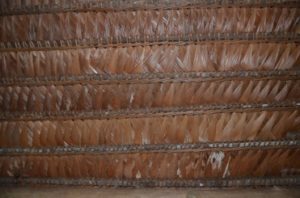 had been laid upon and lashed to rafters made of pona palm. The entire building was an amazing display of both local craftsmanship and the utility of the forest products lying at hand. (A note here: Explorama Lodge’s rooms have since been upgraded and each now has a bathroom with shower. Even generator-produced electricity and Wi-Fi are available during certain hours. A nod to progress I suppose, but the evening lamp-glow and near total isolation from the modern world I sadly miss).
had been laid upon and lashed to rafters made of pona palm. The entire building was an amazing display of both local craftsmanship and the utility of the forest products lying at hand. (A note here: Explorama Lodge’s rooms have since been upgraded and each now has a bathroom with shower. Even generator-produced electricity and Wi-Fi are available during certain hours. A nod to progress I suppose, but the evening lamp-glow and near total isolation from the modern world I sadly miss).
Pablo suggested that before dinner I have a rest from our days’ travel and he directed me to the hammock house. Here, on the perimeter of the Explorama buildings, was a structure of the familiar palm materials. Raised above ground on wooden stilts was a broad, un-walled room with numerous hammocks suspended from the rafters.
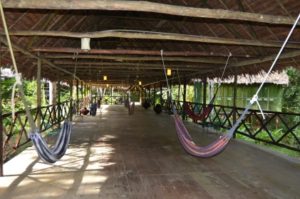 The area was unoccupied and I soon found myself blissfully relaxing as my hammock swayed gently to and fro. Soon, off in the surrounding forest, I heard a soft yet steady rain approaching. Within minutes I was surrounded by the percussive sound of a million raindrops softly striking another million multi-shaped leaves. A cool, incredibly refreshing breeze had come with the rain. And now, of a sudden, came a sound totally novel to my ears. From several points of the compass came low, soft, whooping calls. The voices resembled a muted, less robust version of the first note of the song crooned by the white-handed gibbons I had heard in Malaysia so many years ago. It was the sound of smoky jungle frogs (Leptodactylus) who had
The area was unoccupied and I soon found myself blissfully relaxing as my hammock swayed gently to and fro. Soon, off in the surrounding forest, I heard a soft yet steady rain approaching. Within minutes I was surrounded by the percussive sound of a million raindrops softly striking another million multi-shaped leaves. A cool, incredibly refreshing breeze had come with the rain. And now, of a sudden, came a sound totally novel to my ears. From several points of the compass came low, soft, whooping calls. The voices resembled a muted, less robust version of the first note of the song crooned by the white-handed gibbons I had heard in Malaysia so many years ago. It was the sound of smoky jungle frogs (Leptodactylus) who had  begun their evening’s romancing. These vocalizations have remained one of my treasured rainforest memories. Their sounds seemed archetypical of the rainforest and even now I can bring them to cognizance and find myself thus transported back to their forest. Lying in my hammock, lulled by the soothing rainfall and mesmerized by the melody of the frogs I felt sure I had found my Eden.
begun their evening’s romancing. These vocalizations have remained one of my treasured rainforest memories. Their sounds seemed archetypical of the rainforest and even now I can bring them to cognizance and find myself thus transported back to their forest. Lying in my hammock, lulled by the soothing rainfall and mesmerized by the melody of the frogs I felt sure I had found my Eden.
Down the Amazon: Episode 3 in which I confront some of the rainforest’s most fascinating inhabitants will be coming soon. Thanks for journeying along with me!
